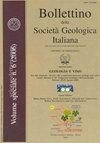Geogenic CO2 flux calculations from the Late Pleistocene Tivoli travertines (Acque Albule Basin, Tivoli, Central Italy)
引用次数: 2
Abstract
The Lapis Tiburtinus travertine of the Acque Albule Basin (Tivoli, Central Italy) is a well-known travertine deposit composed by 10 units separated by unconformity surfaces. This travertine deposition is related to CO2 degassing of thermal waters circulating in deep carbonate-sulphate reservoirs. Since for each mole of calcite precipitated by groundwater, one mole of CO is degassing to the atmosphere, the volumes of travertine deposits 2 can be used as an indirect proxy of the amount of CO2 degassed during travertine deposition.In the present work the volumes of the different travertine units and the cumulative amount of CO2 degassed per depositional unit (FCO2, which range between 1.56×108 mol a-1 to 5.93×108 mol a-1) have been computed. Furthermore, the fluxes of carbon dioxide per unit area (φCO2) were computed and compared to the δ18O curve and pollen data.The computed CO2 fluxes, range between 7.11×105 mol a-1 km-2 and 2.70×106 mol a-1 km-2. These values are minimum estimations of the deep CO2 degassing processes because of dissolution and erosion processes and possible CO2 loss from thermal water before their emergence at springs as well as because only the exposed travertine succession was used as proxy for the entire succession. The comparison of the CO2 flux data with the δ18O curve and pollen data shows that smaller variations in carbon dioxide flux are related to changes in climatic conditions, while greater variations are probably caused by the increase of the deep CO2 degassing process of the Acque Albule hydrothermal system, which is, in turn, relate to the activity of Colli Albani volcanic system.晚更新世Tivoli石灰华(Acque Albule盆地,Tivoli,意大利中部)的地球成因CO2通量计算
Acque Albule盆地(意大利中部Tivoli)的Lapis Tiburtinus钙华矿床是一个著名的钙华矿床,由10个不整合面分隔而成。这种钙华沉积与深部碳酸盐岩-硫酸盐储层循环热水的CO2脱气有关。由于地下水每沉淀一摩尔方解石,就有一摩尔CO向大气脱气,因此钙华沉积物的体积2可以作为钙华沉积过程中脱气CO2量的间接代表。在本工作中,计算了不同石灰华单位的体积和每沉积单位的CO2累计脱气量(FCO2,范围在1.56×108 mol a-1到5.93×108 mol a-1之间)。计算了单位面积二氧化碳通量(φCO2),并与δ18O曲线和花粉数据进行了比较。计算得到的CO2通量范围在7.11×105 mol a-1 km-2和2.70×106 mol a-1 km-2之间。这些值是深层二氧化碳脱气过程的最小估计,因为溶解和侵蚀过程以及热水在泉水中出现之前可能的二氧化碳损失,以及因为只有暴露的钙华演替被用作整个演替的代理。CO2通量数据与δ18O曲线和花粉数据的对比表明,CO2通量的变化较小,与气候条件的变化有关,而较大的变化可能是由于Acque Albule热液系统深层CO2脱气过程的增加,而这又与Colli Albani火山系统的活动有关。
本文章由计算机程序翻译,如有差异,请以英文原文为准。
求助全文
约1分钟内获得全文
求助全文

 求助内容:
求助内容: 应助结果提醒方式:
应助结果提醒方式:


